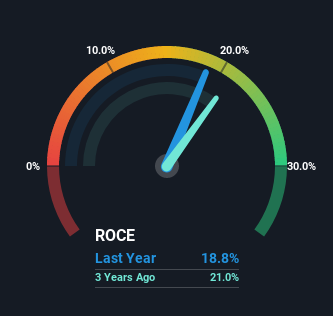
There are a few key trends to look for if we want to identify the next multi-bagger. One common approach is to try and find a company with returns on capital employed (ROCE) that are increasing, in conjunction with a growing amount of capital employed. Ultimately, this demonstrates that it's a business that is reinvesting profits at increasing rates of return. That's why when we briefly looked at Sage Group's (LON:SGE) ROCE trend, we were pretty happy with what we saw.
What is Return On Capital Employed (ROCE)?
Just to clarify if you're unsure, ROCE is a metric for evaluating how much pre-tax income (in percentage terms) a company earns on the capital invested in its business. The formula for this calculation on Sage Group is:
Return on Capital Employed = Earnings Before Interest and Tax (EBIT) ÷ (Total Assets - Current Liabilities)
0.19 = UK£454m ÷ (UK£3.5b - UK£1.1b) (Based on the trailing twelve months to March 2022).
So, Sage Group has an ROCE of 19%. On its own, that's a standard return, however it's much better than the 7.7% generated by the Software industry.
View our latest analysis for Sage Group

In the above chart we have measured Sage Group's prior ROCE against its prior performance, but the future is arguably more important. If you'd like, you can check out the forecasts from the analysts covering Sage Group here for free.
What Can We Tell From Sage Group's ROCE Trend?
While the returns on capital are good, they haven't moved much. The company has consistently earned 19% for the last five years, and the capital employed within the business has risen 31% in that time. 19% is a pretty standard return, and it provides some comfort knowing that Sage Group has consistently earned this amount. Over long periods of time, returns like these might not be too exciting, but with consistency they can pay off in terms of share price returns.
The Key Takeaway
In the end, Sage Group has proven its ability to adequately reinvest capital at good rates of return. In light of this, the stock has only gained 9.9% over the last five years for shareholders who have owned the stock in this period. So because of the trends we're seeing, we'd recommend looking further into this stock to see if it has the makings of a multi-bagger.
Sage Group does have some risks though, and we've spotted 2 warning signs for Sage Group that you might be interested in.
For those who like to invest in solid companies, check out this free list of companies with solid balance sheets and high returns on equity.
New: Manage All Your Stock Portfolios in One Place
We've created the ultimate portfolio companion for stock investors, and it's free.
• Connect an unlimited number of Portfolios and see your total in one currency
• Be alerted to new Warning Signs or Risks via email or mobile
• Track the Fair Value of your stocks
Have feedback on this article? Concerned about the content? Get in touch with us directly. Alternatively, email editorial-team (at) simplywallst.com.
This article by Simply Wall St is general in nature. We provide commentary based on historical data and analyst forecasts only using an unbiased methodology and our articles are not intended to be financial advice. It does not constitute a recommendation to buy or sell any stock, and does not take account of your objectives, or your financial situation. We aim to bring you long-term focused analysis driven by fundamental data. Note that our analysis may not factor in the latest price-sensitive company announcements or qualitative material. Simply Wall St has no position in any stocks mentioned.
About LSE:SGE
Sage Group
Provides technology solutions and services for small and medium businesses in the United States, the United Kingdom, France, and internationally.
Reasonable growth potential with proven track record and pays a dividend.


